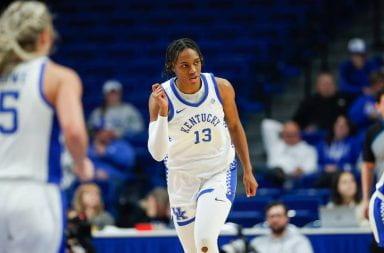The traditionally male-dominated fields of math and science appear to be staying that way at Ohio State.
OSU is last in the Big Ten in percentage of women faculty. These numbers are disappointing to some, but others say there’s more to the data.
Richard Petty, chair of the OSU Department of Psychology, said low numbers of women in these fields can be discouraging to students.
“In higher education, I think it’s really important for students to see people like themselves, because in college this is where you’re preparing for your career,” he said. “If there are no female engineers, classmates or professors that you see, that sort of sends a very implicit message to you that maybe this isn’t where you’re supposed to be.”
Minorities can also fall into a “stereotype threat,” which Petty said happens when someone is concerned that their group might not perform as well as others and they feel they are representing this group.
“So if you’re the only woman in a math class, all of the sudden you start to think, ‘Oh I’m representing all of the women here so I better really do well or people will think women are not very good,'” he said. “And then you get very anxious and it consumes your thoughts and you don’t do very well.”
He said this threat can be combatted with something as simple as a professor assuring the class that historically men and women do equally well, or if the individual recognizes the threat and realizes it is inaccurate.
Allie Lawson, a fourth-year in chemistry, said she has noticed the low number of female professors and students in her classes.
“I remember quite a few times in the chemistry department where I’ve felt blatantly out of place as a woman,” she said. She added that her male peers sometimes make rude comments to her, and one male student told her he was surprised to see a girl in a science building.
It is stereotypes and biases like these that need to be addressed, Petty said. Explicit bias and open discrimination is becoming rarer because it is socially unacceptable. But implicit bias, which is often subconscious, is still prevalent. Implicit bias is when people think they aren’t biased, but in tests they are seen to value a man’s work more than a woman’s. Jill Bystydzienski, professor in and chair of the Department of Women’s, Gender and Sexuality Studies, said OSU’s 33 percent female faculty is on track with the national average of about one-third of college faculty being women. She said one explanation for this is the low number of women in the science, technology, engineering, math and medicine (STEMM) fields.
According to the “2012 Status Report on Women at OSU” by The Women’s Place, which advocates for and analyzes OSU policy relating to women, the College of Nursing has the highest percentage of female tenure-track faculty at 90 percent, while the College of Engineering and the Natural Math and Science division both come in with less than 20 percent of women faculty.
However, OSU is doing better than some other Big Ten schools in terms of STEMM faculty.
Northwestern University reported 11.6 percent female tenure-track faculty in its engineering programs in 2011.
The University of Illinois 2007-2008 “Report of the Provost’s Council on Gender Equity” listed less than 10 percent of women in its College of Engineering, and at the time it also had more than 20 percent female faculty in sciences, math and information sciences and biological sciences.
To compare, OSU has roughly 43,000 undergraduate students and about 2,900 regular tenure-track faculty, according to OSU’s statistical summary from fall 2012. Northwestern has about 8,000 undergraduate students and 2,500 full-time faculty, and the University of Illinois at Urbana-Champaign has almost 32,000 undergraduate students and roughly 1,871 tenure and tenure-track faculty, according to their respective websites. Tenure-track faculty are professors who are guaranteed consideration for tenure.
Bystydzienski said this bias can be found among people of all genders.
“It’s not just men. There’s research that we all have these biases. We inadvertently can evaluate the work of a male and a female differently,” she said.
One of the issues women face in the workplace is the ability to socialize with their peers and superiors, Bystydzienski said.
“Men might socialize more or play sports or something, and sometimes women can break into those clubs, but most of them often do not. They actually have less access to these social networks where decisions are made, issues are discussed,” she said.
She added research of STEMM graduate school students has also showed this effect.
“The male graduate students bond with the male professors, they’re part of the club, they get acculturated into the profession and the women just don’t have that kind of access so they end up doing things more on their own and it takes them longer,” she said.
She said it’s often more difficult for women to get mentors in the field to help them get jobs as well.
Lawson, who recently was accepted into medical school, said this possible continuation of bias in the workplace is troubling.
“It does worry me, but I know that I’m fully capable of doing the work,” she said.
Other students said they are more hopeful that the number of women in STEMM fields will be more balanced in the future.
Margaret Lily Stinstrom, a first-year in biology and secretary of the Women in Math and Science club, said she hopes the fields continue to attract more women.
“There’ll always be hardships in general in achieving your dreams,” she said. “It looks like it’ll eventually balance out, it just takes time.”
Though Lawson and Stinstrom both said they were disturbed by the low percentage of female faculty at OSU, Stinstrom said it’s all about quality over quantity.
“If they’re good quality teachers then they’re going to balance out the statistics,” she said.


